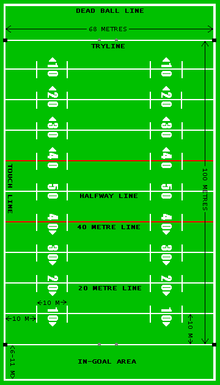Rugby league rules
These are the rules of the sport of rugby league , part of the rugby family of sports .
number of players
There are 2 teams with 17 players each, 13 of whom each play at the same time and four serve as substitutes. The 13 players who start a game are firmly tied to their position and numbered 1–13, the four substitutes are numbered 14–17.
The rugby league field
The game is played on a rectangular field with a length of 120 meters and a width of 58-68 meters. In the middle of the field is the 50-meter “halfway” line. Each side from the 50-meter line is identical and divided into 10-meter sections, which are marked with lines. There is therefore a 40, 30, 20 and 10 meter line. Then comes the goal line or "tryline", which delimits exactly 100 meters for the general game. In the middle of the goal line there are two goal posts in the shape of the letter H with which extra points can be scored. The dead ball line is 6–12 meters behind the goal line. The area between these two lines is called the “in-goal area”. The dead ball line and the sidelines form the boundaries of the playing field. If the ball or parts of a player in possession of the ball touch the ground outside of the line, the ball is said to be dead.
Counting method
There are four ways to get points.
- An attempt earns four points and is the most important means of scoring. To do this, the ball in the in-goal area must be placed on the floor with pressure.
- After an attempt, the scoring team has the opportunity to upgrade the attempt with a shot on goal and score two extra points.
- A penalty kick earns two points.
- A drop goal is worth one point.
The attempt counts only 4 points in rugby league, while in “conventional” rugby union it earns 5 points.
Web link
- Rugby League rules at the RLEF (English; PDF; 280 kB)
